Twisted Metal: Black Preview
We take another look at the upcoming car combat game for the PS2.
Fans of both the Twisted Metal series and car-combat games in general have a lot to look forward to. When Twisted Metal: Black is unleashed this June, the car-combat subgenre is sure to be taken by storm. The ripples sent out thus far by the information available on the game have already been felt by those who have been paying attention, and the game promises to not only revolutionize the genre but to demonstrate the power of the most-talked-about next-generation console currently available: Sony's PlayStation 2.

The re-forming of the company formerly known as SingleTrac--the development house that created the franchise and developed the strongest installments in the series--brought many loyal gamers hope that the name Twisted Metal would be restored to its original glory. After a week of running amok in TMB's monstrous environments, uncovering a multitude of secrets, and literally destroying everything in sight, we are pleased to confirm the fans' highest hopes.
Back in late 1995, when the original Twisted Metal was released, gamers were entrenched in a young but quickly stagnating car-combat subgenre. Up to that point, there were only a few mediocre titles to populate the fledgling class, consisting mostly of demolition derby-type games, and they had received little fanfare for various reasons. Twisted Metal rejuvenated and reinvented the subgenre, bringing unique characters, vehicles, and level design with it, and rocketed to the top of the sales charts as a result. SingleTrac followed up the success of the first installment by releasing Twisted Metal 2--arguably the definitive car combat game--little more than a year later. After deciding that the PlayStation hardware of the time couldn't handle the grandiose ideas SingleTrac wanted to flesh out for the next sequel, though, the studio elected to pass the licensing on to another development house--namely 989 Studios. The sequels that followed were controversial; most die-hard fans of the series were utterly dismayed at the altered physics model and the quirkiness of the reworked game design. Newcomers weren't very receptive to this, either. Even today, mentioning Twisted Metal 3 around fans of the old games is sure to annoy most of them. And while Twisted Metal 4 was an improvement on TM3, it still didn't quite have the charm of the first two games.
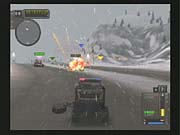
Fast-forward to the present. The Twisted Metal franchise has been taken back by the team responsible for starting it--now known as Incognito Entertainment--and judging by what we've seen so far, the game has taken two important steps. The first could be viewed as a step backward: By bridging the gap between the new and classic games of the series, Incognito has allowed it to regain some much-needed footing in the foundation of what made the games so unique. The second is a big and obvious step forward--it's a dive into the latest revolution in console-gaming technology. Twisted Metal: Black not only takes both of these steps in stride, but it promises to push the envelope by outdoing its predecessors, all while learning from similar games that were released by other developers--for example, the influence of Luxoflux's Vigilante 8 series can be seen in the way the weapons are reflected on the exterior of the car.
Fans of the series will immediately fall in love with Twisted Metal: Black. The game brings back the physics of the first two installments and stars some of the old favorite characters, along with a batch of completely new ones. Some of the new characters will feel familiar, due to the use of some of the old weapons. So while Warthog the Hummer and Thumper the pink Impala didn't make the cut, their weapons and style have. Specifically, Outlaw, the police car, has been reworked entirely to look like a large SUV, reminiscent of Warthog in its control and look. And the electrical attack that the old Outlaw used has been passed on to a new character, Crazy 8. Outlaw's new weapon has taken the form of a gunner who sits on a rotating seat above the truck with a powerful Gatling gun that tracks enemies. Thumper's extremely powerful frontal napalm assault has been passed on to the new character White Knight (a hidden character)--a gutted station wagon with tank treads for wheels.
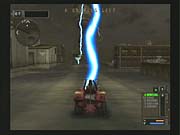
The trend of bringing a new construction vehicle with each game continues in TMB with Manslaughter--a dump truck loaded with volcanic rock that can be thrown forward in an explosive attack or dropped behind as a more powerful version of the land mine. Some other characters have made the jump to the PS2 without changing at all, such as Spectre, who, aside from having a new driver, is basically the same as in the earlier games. Yellowjacket, the cab that was first introduced in Twisted Metal 1, is also present, and it has an attack that causes spikes to spring from its chassis for the purpose of ramming.
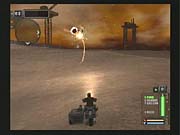
The level design is reminiscent of the first two games. Twisted Metal 3 tried to follow in the footsteps of its predecessors by making levels akin to those in the previous games, but failed in the creativity department. TMB, though, manages to do this with style. One of the most popular levels from the first two Twisted Metal games was Cyburbia, a sprawling level consisting of suburban neighborhoods and a freeway that looped around it. This level was obviously the inspiration for one of the new levels, aptly named the Suburbs. The level is absolutely huge and is composed of several different areas. At the center of the level is a small town, complete with gas stations, a church, and even a warehouse-size store in the vein of a Wal-Mart or Target. On the outskirts of town is a carnival with a large Ferris wheel that can be knocked free of its cradle to roll through town and destroy everything in its path. Directly below the carnival is an industrial district complete with blackened skies and populated with large buildings that spew pollutants. Within the industrial area lies a particular building wreathed in smog that, when triggered by the appropriate power-up, fires soot and lightning that damage anything in its vicinity. There is also a water tower near the building that can be knocked over. When this happens, it dumps its watery contents on top of the surrounding buildings, resulting in a waterfall effect. In short, the amount of interactivity within the stage is simply astounding. You are literally able to destroy most of the buildings in the stage by crashing directly through them or by hitting them with weapons.
The suburb isn't the only giant environment. The level called Skyscrapers is directly influenced by the Rooftops level in TM2 but is much larger. While there are many angled roofs that act as ramps scattered through the stage, the majority are flat and offset so as to allow the cars access to the level's many corners. The level contains lots of details. There's a darkly lit chapel on one of these roofs, adorned with red stained glass and gothic granite statues, as well as a downed airliner that serves as a ramp from the lower levels to the higher.] Some of the levels were designed on a much smaller scale, though, like the Snowy Hills level. In spite of being smaller, in many ways it's more difficult, simply because there is nowhere to run and hide; you are forced to stay in the action and face the music at all times.
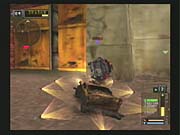
Every level has its secrets as well. Chances are, if an object in the level looks like it could be blown up, sooner or later it will be. On the Junkyard level, there is a jumbo jet that circles the perimeter, and when it is shot down, it will crash down into the environment and punch a hole into a hill, which in turn opens up a tunnel that runs through to a trap door that is otherwise inaccessible. In the Downtown level, the side of a building can be blown open with the same domino effect.
As touched on before, there are environmental weapons that can be triggered on each and every level. They can be in the form of anything from attack helicopters flying through the level, to cannons under gutted aircraft suspended in midair by cables, to blimps equipped with missiles. Hazards like car crushers dot the landscape as well and are constantly in effect.

The pacing of the game is downright frantic, and the music only serves to enhance the experience. All of the songs are interactive in that they will adjust in intensity according to what's happening onscreen. If you take to the hills in the suburbs, for instance, the music will lower in volume and drop into a crouched lull, ready to spring back into powerful guitar riffs and bass beats at any given moment. Each level has its own distinct sound, and the score consists mostly of dark and edgy industrial-type music, which rings like it's one part Nine Inch Nails and two parts Terminator theme. The sound effects are top notch as well--you can identify who is shooting what weapon at you just by listening. Fire and homing missiles whistle like bottle rockets, and ricochet discs make a sound like spinning fireworks. If you hear the blasting horn of Darkside or hear the familiar scream of Spectre's homing missile, you know what's coming right before it arrives in force. The volume of every sound reflects distance as well, so you can accurately gauge whether you should actively evade the coming assault or worry about other things first. In short, the sense of dread the sounds and music instill complements the dark atmosphere perfectly.
Graphically, Twisted Metal: Black is a technical marvel. Every car model is detailed to the extreme, bristling with machine guns, armor, and different qualities of paint. Each car is completely unique in design and color. Some cars, such as Yellowjacket, will have a rattling supercharger rising from the hood and a checkered stripe from hood to tailgate, while others, like Spectre, will have lighter shades of paint and will sport roll bars complemented by windshield armor. The levels are just as detailed. Even buildings that can't be completely destroyed are clad in texture-coated polygons, which represent damage very impressively
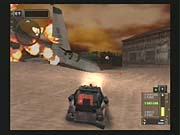
The explosions and gunfire that incessantly rip through the environments are quite a spectacle to behold. The fire effects are especially well done, with rippling flames dancing above smoldering heaps of wreckage, and outward-rolling fireballs. When a car is hit by a gas can or any number of other flame-based attacks, the vehicle will catch fire, and the flames will shift according to the direction the car is moving. Explosions send brilliant pinpricks of light in all directions as if it's the Fourth of July. Smoke and dust effects are of a quality that hasn't been seen before, with billowing clouds that roll upward before slowly fading away. These effects also manage to avoid leaving darker lines on the ground where the effect comes in contact with the terrain, which can spoil the illusion.
The game also makes excellent use of lighting. As the name of the game implies, everything is dark and dreary, and most of the contest takes place toward dusk and well into the night. Some levels, such as Snowy Hills, take place during the day, but even then the sky is filled with clouds that release flurries of little snowflakes that slowly drift down around you. On the Junkyard level, things start right as the sun dips below the horizon, and soon everything is cloaked in an inky darkness. Before you know it, storm clouds are rumbling, and a torrent of rain is pouring down on everything. The raindrops even become brighter as your headlights refract light through them.
Through all of this, the frame rate remains a rock solid 60fps and gives the game a very sharp and ultrarealistic look. We only encountered one instance of slowdown, isolated in the Freeway level, which just couldn't load textures fast enough. We ended up driving over regions where the textures hadn't loaded in time, and the slowdown arose on these occasions. Judging by the state of the level, though, it's safe to say that this is only a temporary glitch and will be corrected before the game's release.
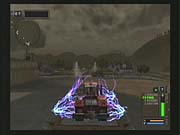
In previous builds, there was a concern that there weren't enough power-ups available and that the game might turn into a treasure hunt for armament. This is no longer the case. On every level we played there were weapons in sight at every turn, and many times they could be spotted in all directions, recognizable from a distance because of a color-recognition system. Though each type of weapon has its own icon, the icons are really unnecessary--you will get to know each weapon by color. The system is fairly easy to pick up, as after each weapon is fired, it leaves a contrail behind that is the same color as its icon. For example, homing missiles leave a purplish contrail, and their icon is of a similar purplish hue, while fire missiles leave red contrails and have red icons.
All in all, Twisted Metal: Black is turning out to be a killer app that could very well sell PS2s much like Final Fantasy X and Metal Gear Solid 2: Sons of Liberty inevitably will. Not only does it push the envelope on the technical side of things, but it's also a pleasure to play. Twisted Metal: Black is set to hit store shelves in the later part of June 2001.
Got a news tip or want to contact us directly? Email news@gamespot.com
Join the conversation